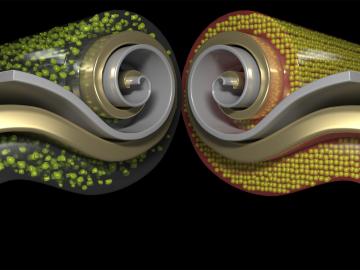
Filter News
Area of Research
- (-) Energy Science (161)
- (-) Fusion Energy (10)
- (-) Materials (145)
- (-) Nuclear Systems Modeling, Simulation and Validation (1)
- Advanced Manufacturing (5)
- Biological Systems (2)
- Biology and Environment (139)
- Biology and Soft Matter (1)
- Computational Biology (2)
- Computational Engineering (2)
- Computer Science (4)
- Electricity and Smart Grid (1)
- Energy Frontier Research Centers (1)
- Energy Sciences (1)
- Fuel Cycle Science and Technology (1)
- Functional Materials for Energy (2)
- Fusion and Fission (34)
- Isotope Development and Production (1)
- Isotopes (11)
- Materials for Computing (20)
- Mathematics (1)
- National Security (21)
- Neutron Science (128)
- Nuclear Science and Technology (42)
- Quantum information Science (2)
- Supercomputing (93)
News Topics
- (-) Bioenergy (30)
- (-) Biomedical (10)
- (-) Energy Storage (85)
- (-) Environment (64)
- (-) Exascale Computing (3)
- (-) Nanotechnology (41)
- (-) Neutron Science (42)
- (-) Nuclear Energy (30)
- (-) Polymers (21)
- 3-D Printing/Advanced Manufacturing (90)
- Advanced Reactors (16)
- Artificial Intelligence (13)
- Big Data (7)
- Biology (12)
- Biotechnology (4)
- Buildings (38)
- Chemical Sciences (33)
- Clean Water (10)
- Composites (19)
- Computer Science (38)
- Coronavirus (14)
- Critical Materials (19)
- Cybersecurity (10)
- Fossil Energy (2)
- Frontier (4)
- Fusion (18)
- Grid (40)
- High-Performance Computing (9)
- Hydropower (3)
- Irradiation (1)
- Isotopes (13)
- ITER (1)
- Machine Learning (10)
- Materials (94)
- Materials Science (90)
- Mathematics (3)
- Mercury (3)
- Microelectronics (1)
- Microscopy (29)
- Molten Salt (3)
- National Security (6)
- Partnerships (16)
- Physics (28)
- Quantum Computing (3)
- Quantum Science (12)
- Security (7)
- Simulation (4)
- Space Exploration (5)
- Statistics (1)
- Summit (7)
- Transportation (70)
Media Contacts

Oak Ridge National Laboratory researchers serendipitously discovered when they automated the beam of an electron microscope to precisely drill holes in the atomically thin lattice of graphene, the drilled holes closed up.

While studying how bio-inspired materials might inform the design of next-generation computers, scientists at ORNL achieved a first-of-its-kind result that could have big implications for both edge computing and human health.

Researchers at ORNL have developed a new method for producing a key component of lithium-ion batteries. The result is a more affordable battery from a faster, less wasteful process that uses less toxic material.

The Department of Energy’s Oak Ridge National Laboratory has exclusively licensed battery electrolyte technology to Safire Technology Group. The collection of five patented technologies is designed for a drop-in additive for lithium-ion batteries that prevents explosions and fire from impact.

Eight ORNL scientists are among the world’s most highly cited researchers, according to a bibliometric analysis conducted by the scientific publication analytics firm Clarivate.

Oak Ridge National Laboratory scientists designed a recyclable polymer for carbon-fiber composites to enable circular manufacturing of parts that boost energy efficiency in automotive, wind power and aerospace applications.

As the United States shifts away from fossil-fuel-burning cars and trucks, scientists at the Department of Energy’s Oak Ridge and Argonne national laboratories are exploring options for another form of transportation: trains. The research focuses on zero-carbon hydrogen and other low-carbon fuels as viable alternatives to diesel for the rail industry.

Laboratory Director Thomas Zacharia presented five Director’s Awards during Saturday night's annual Awards Night event hosted by UT-Battelle, which manages ORNL for the Department of Energy.

Sheng Dai, a Corporate Fellow and section head at the Department of Energy’s Oak Ridge National Laboratory, has been selected by the DOE Office of Science as a 2023 Distinguished Scientist Fellow.

Rama Vasudevan, a research scientist at the Department of Energy’s Oak Ridge National Laboratory, has been elected a Fellow of the American Physical Society, or APS. The honor recognizes members who have made significant contributions to physics and its application to science and technology.


